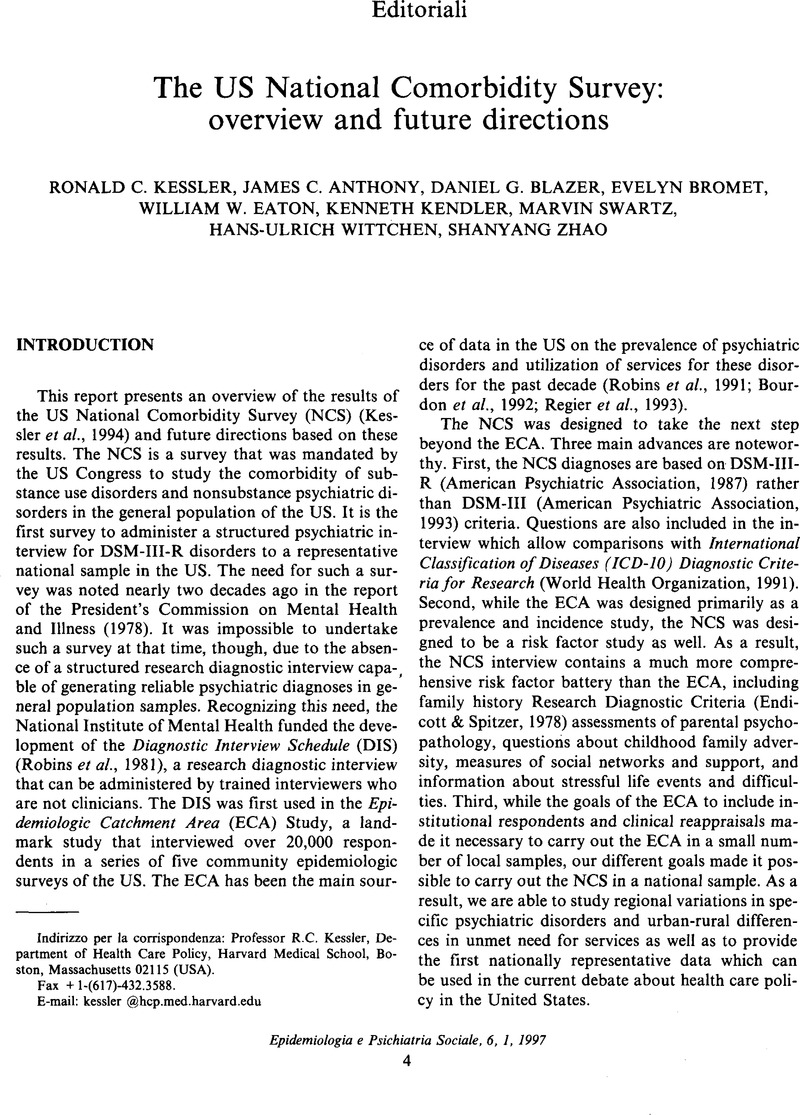Crossref Citations
This article has been cited by the following publications. This list is generated based on data provided by Crossref.
Lieb, Roselind
Isensee, Barbara
Höfler, Michael
and
Wittchen, Hans-Ulrich
2002.
Parental depression and depression in offspring: evidence for familial characteristics and subtypes?.
Journal of Psychiatric Research,
Vol. 36,
Issue. 4,
p.
237.
Savage, Seddon R.
Joranson, David E.
Covington, Edward C.
Schnoll, Sidney H.
Heit, Howard A.
and
Gilson, Aaron M.
2003.
Definitions related to the medical use of opioids: Evolution towards universal agreement.
Journal of Pain and Symptom Management,
Vol. 26,
Issue. 1,
p.
655.
Tuchman, Ellen
2003.
Methadone and Menopause: Midlife Women in Drug Treatment.
Journal of Social Work Practice in the Addictions,
Vol. 3,
Issue. 2,
p.
43.
Michael, Tanja
and
Margraf, Jürgen
2004.
Epidemiology of anxiety disorders.
Psychiatry,
Vol. 3,
Issue. 4,
p.
2.
Verona, Edelyn
and
Sachs-Ericsson, Natalie
2005.
The Intergenerational Transmission of Externalizing Behaviors in Adult Participants: The Mediating Role of Childhood Abuse..
Journal of Consulting and Clinical Psychology,
Vol. 73,
Issue. 6,
p.
1135.
Sachs-Ericsson, Natalie
Blazer, Dan
Plant, E. Ashby
and
Arnow, Bruce
2005.
Childhood Sexual and Physical Abuse and the 1-Year Prevalence of Medical Problems in the National Comorbidity Survey..
Health Psychology,
Vol. 24,
Issue. 1,
p.
32.
VanDeMark, Nancy R.
Russell, Lisa A.
O'Keefe, Maura
Finkelstein, Norma
Noether, Chanson D.
and
Gampel, Joanne C.
2005.
Children of mothers with histories of substance abuse, mental illness, and trauma.
Journal of Community Psychology,
Vol. 33,
Issue. 4,
p.
445.
Finkelstein, Norma
Rechberger, Elke
Russell, Lisa A.
VanDeMark, Nancy R.
Noether, Chanson D.
O'Keefe, Maura
Gould, Karen
Mockus, Susan
and
Rael, Melissa V.
2005.
Building resilience in children of mothers who have Co-occurring Disorders and histories of Violence.
The Journal of Behavioral Health Services & Research,
Vol. 32,
Issue. 2,
p.
141.
Finkelstein, Norma
Rechberger, Elke
Russell, Lisa A.
VanDeMark, Nancy R.
Noether, Chanson D.
O??Keefe, Maura
Gould, Karen
Mockus, Susan
and
Rael, Melissa
2005.
Building Resilience in Children of Mothers Who Have Co-occurring Disorders and Histories of Violence.
The Journal of Behavioral Health Services & Research,
Vol. 32,
Issue. 2,
p.
141???154.
Nicholson, Joanne
Finkelstein, Norma
Williams, Valerie
Thom, Jennifer
Noether, Chanson
and
DeVilbiss, Megan
2006.
A Comparison of Mothers with Co-occurring Disorders and Histories of Violence Living with or Separated from Minor Children.
The Journal of Behavioral Health Services & Research,
Vol. 33,
Issue. 2,
p.
225.
Zvolensky, Michael J.
Sachs-Ericsson, Natalie
Feldner, Matthew T.
Schmidt, Norman B.
and
Bowman, Carrie J.
2006.
Neuroticism moderates the effect of maximum smoking level on lifetime panic disorder: A test using an epidemiologically defined national sample of smokers.
Psychiatry Research,
Vol. 141,
Issue. 3,
p.
321.
Hernandez, Annya
and
Sachs-Ericsson, Natalie
2006.
Ethnic Differences in Pain Reports and the Moderating Role of Depression in a Community Sample of Hispanic and Caucasian Participants With Serious Health Problems.
Psychosomatic Medicine,
Vol. 68,
Issue. 1,
p.
121.
Thombs, Brett D.
Lewis, Charles
Bernstein, David P.
Medrano, Martha A.
and
Hatch, John P.
2007.
An evaluation of the measurement equivalence of the Childhood Trauma Questionnaire—Short Form across gender and race in a sample of drug-abusing adults.
Journal of Psychosomatic Research,
Vol. 63,
Issue. 4,
p.
391.
Sachs-Ericsson, Natalie
Kendall-Tackett, Kathleen
and
Hernandez, Annya
2007.
Childhood abuse, chronic pain, and depression in the National Comorbidity Survey.
Child Abuse & Neglect,
Vol. 31,
Issue. 5,
p.
531.
Michael, Tanja
Zetsche, Ulrike
and
Margraf, Jürgen
2007.
Epidemiology of anxiety disorders.
Psychiatry,
Vol. 6,
Issue. 4,
p.
136.
Bernstein, Amit
Zvolensky, Michael J.
Schmidt, Norman B.
and
Sachs-Ericcson, Natalie
2007.
Developmental Course(s) of Lifetime Cigarette Use and Panic Attack Comorbidity.
Behavior Modification,
Vol. 31,
Issue. 1,
p.
117.
Mason, Carolyn
Subedi, Sree
and
Davis, Robert B.
2007.
CLIENTS WITH MENTAL ILLNESS AND THEIR CHILDREN: IMPLICATIONS FOR CLINICAL PRACTICE.
Issues in Mental Health Nursing,
Vol. 28,
Issue. 10,
p.
1105.
Babson, Kimberly A.
Feldner, Matthew T.
Sachs-Ericsson, Natalie
Schmidt, Norman B.
and
Zvolensky, Michael J.
2008.
Nicotine dependence mediates the relations between insomnia and both panic and posttraumatic stress disorder in the NCS-R sample.
Depression and Anxiety,
Vol. 25,
Issue. 8,
p.
670.
Zvolensky, Michael J.
Leyro, Teresa
Bernstein, Amit
Feldner, Matthew T.
Yartz, Andrew R.
Babson, Kimberly
and
Bonn-Miller, Marcel O.
2008.
Anxiety In Health Behaviors And Physical Illness.
p.
3.
Buckner, Julia D.
Timpano, Kiara R.
Zvolensky, Michael J.
Sachs-Ericsson, Natalie
and
Schmidt, Norman B.
2008.
Implications of comorbid alcohol dependence among individuals with social anxiety disorder.
Depression and Anxiety,
Vol. 25,
Issue. 12,
p.
1028.





